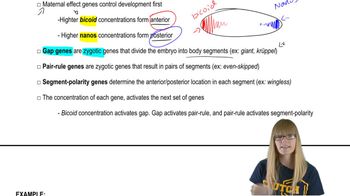Radiation is frequently used as part of the treatment of cancer. The radiation works by damaging DNA and components of the cell. How can radiation treatment control or cure cancer?
Table of contents
- 1. Introduction to Genetics51m
- 2. Mendel's Laws of Inheritance3h 37m
- 3. Extensions to Mendelian Inheritance2h 41m
- 4. Genetic Mapping and Linkage2h 28m
- 5. Genetics of Bacteria and Viruses1h 21m
- 6. Chromosomal Variation1h 48m
- 7. DNA and Chromosome Structure56m
- 8. DNA Replication1h 10m
- 9. Mitosis and Meiosis1h 34m
- 10. Transcription1h 0m
- 11. Translation58m
- 12. Gene Regulation in Prokaryotes1h 19m
- 13. Gene Regulation in Eukaryotes44m
- 14. Genetic Control of Development44m
- 15. Genomes and Genomics1h 50m
- 16. Transposable Elements47m
- 17. Mutation, Repair, and Recombination1h 6m
- 18. Molecular Genetic Tools19m
- 19. Cancer Genetics29m
- 20. Quantitative Genetics1h 26m
- 21. Population Genetics50m
- 22. Evolutionary Genetics29m
19. Cancer Genetics
Cancer Mutations
Problem C.8a
Textbook Question
The inheritance of certain mutations of BRCA1 can make it much more likely that a woman will develop breast or ovarian cancer in her lifetime. Can you say with certainty that a woman inheriting a mutation of BRCA1 will definitely develop breast or ovarian cancer in her lifetime? Why or why not?
 Verified step by step guidance
Verified step by step guidance1
Understand that inheriting a mutation in the BRCA1 gene increases the risk of developing breast or ovarian cancer, but it does not guarantee that cancer will develop. This is because BRCA1 mutations are considered risk factors, not deterministic causes.
Recognize the concept of penetrance in genetics, which refers to the proportion of individuals with a particular genetic mutation who actually express the associated trait or disease. BRCA1 mutations have incomplete penetrance.
Consider environmental factors, lifestyle, and other genetic factors that can influence whether a woman with a BRCA1 mutation will develop cancer. These factors interact with the mutation to affect cancer risk.
Note that genetic counseling and testing provide probabilities or risk assessments rather than certainties, reflecting the complex nature of gene-environment interactions.
Summarize that while a BRCA1 mutation significantly raises the likelihood of cancer, it is not a definitive predictor, so a woman inheriting the mutation may or may not develop breast or ovarian cancer during her lifetime.
 Verified video answer for a similar problem:
Verified video answer for a similar problem:This video solution was recommended by our tutors as helpful for the problem above
Video duration:
2mPlay a video:
Was this helpful?
Key Concepts
Here are the essential concepts you must grasp in order to answer the question correctly.
BRCA1 Gene and Its Role
BRCA1 is a gene that produces proteins responsible for repairing DNA damage. Mutations in BRCA1 can impair this repair process, increasing the risk of developing breast and ovarian cancers. However, not all mutations have the same effect, and the presence of a mutation raises risk but does not guarantee cancer.
Recommended video:
Guided course

Segmentation Genes
Genetic Penetrance
Penetrance refers to the proportion of individuals with a specific genetic mutation who actually express the associated trait or disease. In the case of BRCA1 mutations, penetrance is incomplete, meaning some women with the mutation may never develop cancer, while others do, due to various genetic and environmental factors.
Recommended video:
Guided course

Penetrance and Expressivity
Risk Factors and Multifactorial Inheritance
Cancer development is influenced by multiple factors beyond a single gene mutation, including lifestyle, environment, and other genetic variations. Thus, inheriting a BRCA1 mutation increases risk but does not act alone, making cancer a multifactorial disease where risk is probabilistic, not deterministic.
Recommended video:
Guided course

Organelle Inheritance
Related Videos
Related Practice
Textbook Question
476
views


